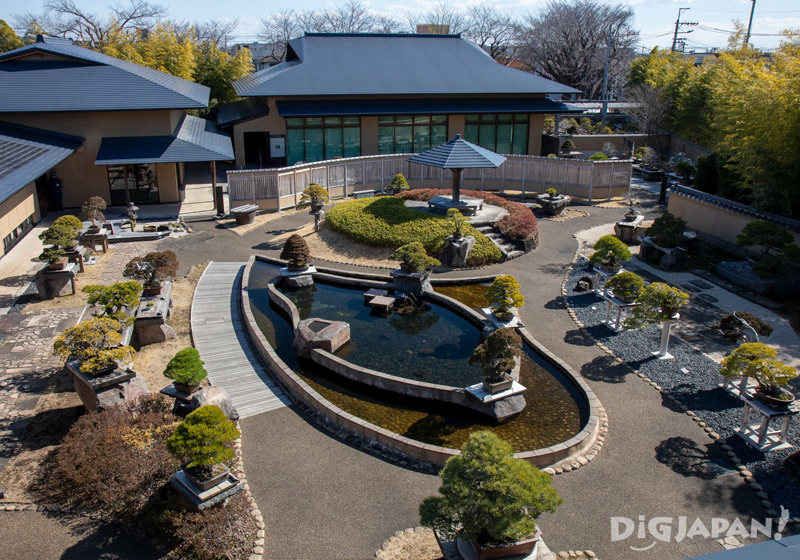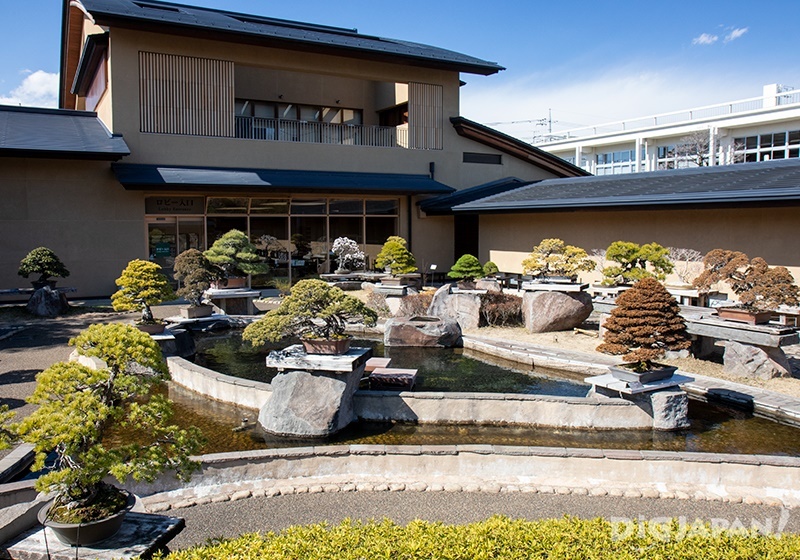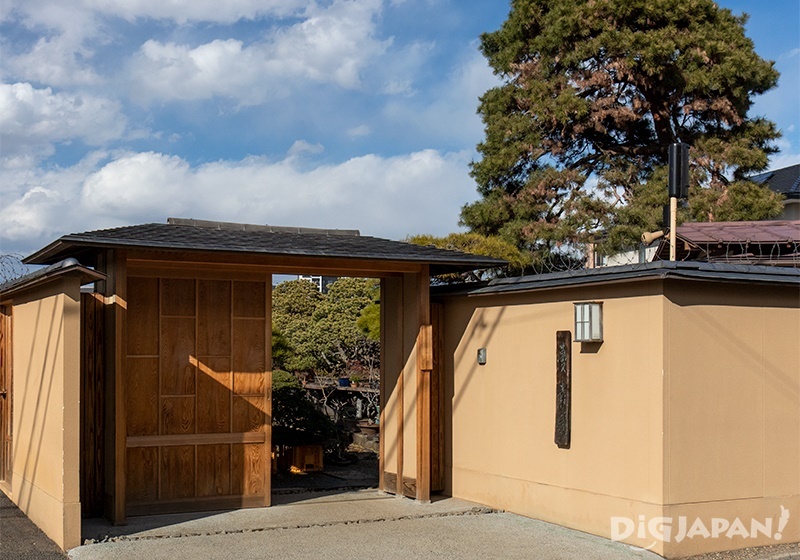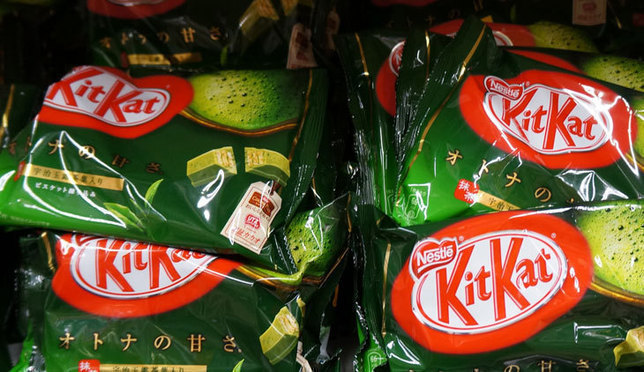- TOP
- Search Criteria
- Visiting Omiya Bonsai Village

STORY
A Whole Town Dedicated to Bonsai! Visiting Omiya Bonsai Village
Japanese culture and art are often closely connected with nature and its representation. One of the best examples of this is bonsai (盆栽), the art of growing small trees that mimic the shape of their full size counterpart. The main concept of bonsai is to condense the majestic appearance and feel of a fully grown tree into a single pot. This is achieved through careful watering, pruning, repotting and wiring of the branches.
If you're interested in learning a bit about bonsai and would like to see some up close, Omiya Bonsai Village in Tokyo is a place you can't miss!
Interesting fact, when the Bonsai Village was founded the community had four conditions for residents to join it. They needed to possess at least 10 bonsai, agree to open their garden to the public, don't build two-story houses and only use hedges as live fencing.
Today, Omiya Bonsai Village includes five bonsai gardens that you can visit, and there's also a bonsai museum right nearby. The area has a very quiet and rural feel, with pretty streets lined with well-kept houses. It's pleasant to just walk around here. Many of the streets are named after the trees that are planted along them. There's a maple street, a cherry blossom street, a zelkova street, and so on. Walking around, you'll actually spot a lot of bonsai trees inside the gardens of the local residents!
The closest train station to Omiya Bonsai Village is Omiya-Koen, which is only a 3 minute train ride from JR Omiya Station. Most major places in Tokyo like Ueno, Ikebukuro and Shinjuku are within 30 minutes from Omiya by train.
Inside Omiya-Koen Station you'll find maps of the area and pamphlets with all the information you need. Funny enough, outside the station is a huge tree.

The first place I'd recommend to visit is the Omiya Bonsai Art Museum, where you can learn everything about the origin of bonsai, how they are made, different types of bonsai and even how to look at and appreciate them. This lovely museum includes an indoor bonsai exhibition, an outdoor bonsai garden that you can walk around in (photo above), and a special exhibition room dedicated to the art and history of bonsai and Omiya Bonsai Village.
The Collection Gallery is where you'll find most of the information about bonsai. Here you'll also be able to enjoy weekly displays of seasonal bonsai and related items like bonsai pots and suiseki stones.

The last part of the Collection Gallery is a reproduction of bonsai displays inside Japanese rooms, showcasing three different styles.
The bonsai garden is an outdoor area where you can walk around and admire many types of plants from all angles. You can also get a nice view of the garden from a terrace on the second floor.

One of the museum's largest bonsai, a Japanese white pine called Chiyo-no-matsu, is set on a turntable so caretakers can control which side of the tree gets the sunlight.

In the reception area you'll also find bonsai-related souvenirs.
Information inside the museum is displayed in Japanese and English. There is also a collection guide available for smartphone in Japanese, English, Chinese and Korean. Photography is allowed in some areas of the garden and in the lobby.
Address: 2-24-3 Toro-cho, Kita-ku, Saitama-shi, Saitama (MAP)
Hours: March-October 9:00 a.m. - 4:30 p.m., November-February 9:00 a.m. - 4:00 p.m. (last admission 30 minutes before closure)
Closed on Thursdays (except for National Holidays), December 29-January 3, and during exhibition preparations.
Fee: 310 yen / High school, university students and persons over 65: 150 yen / Elementary and junior high school students: 100 yen / Reduced prices for people with disabilities and groups over 20 people (see the official website)
Access: 5 min. walk from Toro Station on The JR Utsunomiya Line / 10 min. walk from Omiya Koen Station on the Tobu Urban Park Line
Website: https://www.bonsai-art-museum.jp/en/
*All bonsai gardens are closed on Thursdays. Please note that photography is usually not allowed inside.
Step through the wooden gate that looks like the entrance to a traditional Japanese house and you'll find yourself in a world of miniature trees. Along with traditional plants, here you'll also be able to see Saika Bonsai, a type of bonsai developed by this very garden. They are also the only garden that holds bonsai lessons in English.
Address: 268 Bonsai-cho, Kita-ku, Saitama-shi, Saitama (MAP)
Hours: 9:00 a.m. - 6:00 p.m.
Website (Japanese-only): https://www.seikouen.cc/
This garden has contributed to the bonsai world by educating people in the art of bonsai since 1966. Here you'll see many Goyo-matsu (Japanese White Pine) and other tree varieties.
Address: 247 Bonsai-cho, Kita-ku, Saitama-shi, Saitama (MAP)
Hours: 9:00 a.m. - 5:00 p.m.
Another impressive display can be found at Fuyo-en, which is renown for its Zoki bonsai (trees that change throughout the seasons). Depending on the time of your visit you'll be able to enjoy green leaves, fall foliage, flowers, fruits, or beautiful bare branches.
Address: 96 Bonsai-cho, Kita-ku, Saitama-shi, Saitama (MAP)
Hours: 08:00 a.m.- 5:30 p.m.
Closed on Thursday (except for National Holidays)
Website: https://www.fuyoen.co.jp/
Mansei-en is one of Japan's most famous bonsai gardens that puts emphasis not only in the plants but also in the decorative suiseki stones, bonsai tables and tools. There is a Shimpaku (Japanese Juniper) here that's estimated to be over 1,000 years old.
Address: 285 Bonsai-cho, Kita-ku, Saitama-shi, Saitama (MAP)
Hours: 9:00 a.m. - 4:00 p.m.

This garden focuses on giving its bonsai a more natural look, without the use of wires to shape the branches. Kyuka-en is also renown for developing tools like bonsai shears.
Address: 131 Bonsai-cho, Kita-ku, Saitama-shi, Saitama (MAP)
Hours: 9:00 a.m. - 5:00 p.m.
Website: http://www.iris.dti.ne.jp/~kyukaen/index-e.htm
*The above article is based on information from February 2021.
*Prices, business hours and other information in this article are subject to change.
About the Author
Laura is an Italian living and working in Tokyo. She loves exploring hidden and unknown places, taking pictures and listening to Punk Rock music. When she’s not busy doing the above, she might enjoy a craft beer or play the sanshin (an Okinawan instrument similar to a shamisen).
If you're interested in learning a bit about bonsai and would like to see some up close, Omiya Bonsai Village in Tokyo is a place you can't miss!
What (and Where) is Omiya Bonsai Village?
Located just north of Tokyo in Saitama Prefecture, Omiya Bonsai Village was established in 1925, when a group of bonsai gardeners moved their businesses here from Tokyo. After the 1923 Great Kanto Earthquake, these people were looking for a suitable area to cultivate bonsai, with fresh air and good water.
The area has a quiet rural feel.

Bonsai pictures on the sidewalk!
Interesting fact, when the Bonsai Village was founded the community had four conditions for residents to join it. They needed to possess at least 10 bonsai, agree to open their garden to the public, don't build two-story houses and only use hedges as live fencing.
Today, Omiya Bonsai Village includes five bonsai gardens that you can visit, and there's also a bonsai museum right nearby. The area has a very quiet and rural feel, with pretty streets lined with well-kept houses. It's pleasant to just walk around here. Many of the streets are named after the trees that are planted along them. There's a maple street, a cherry blossom street, a zelkova street, and so on. Walking around, you'll actually spot a lot of bonsai trees inside the gardens of the local residents!


Inside Omiya-Koen Station you'll find maps of the area and pamphlets with all the information you need. Funny enough, outside the station is a huge tree.
Learn Everything About Bonsai at the Omiya Bonsai Art Museum

The first place I'd recommend to visit is the Omiya Bonsai Art Museum, where you can learn everything about the origin of bonsai, how they are made, different types of bonsai and even how to look at and appreciate them. This lovely museum includes an indoor bonsai exhibition, an outdoor bonsai garden that you can walk around in (photo above), and a special exhibition room dedicated to the art and history of bonsai and Omiya Bonsai Village.



The last part of the Collection Gallery is a reproduction of bonsai displays inside Japanese rooms, showcasing three different styles.



One of the museum's largest bonsai, a Japanese white pine called Chiyo-no-matsu, is set on a turntable so caretakers can control which side of the tree gets the sunlight.
Quick Tips to Appreciate Bonsai!
1. Determine the front of the tree: bonsai trees have a front and back! To determine which is the front, look at the side where the branches are more open to let the viewer see the trunk. Also, if you look at it from the side you should see that the tree is "bowing" slightly. The direction of the bow is the front.
2. Look up at the bonsai, not down: get into a position where you're looking up at the tree to feel the power of the big tree that it represents. Changing your point of view really changes the perspective!
1. Determine the front of the tree: bonsai trees have a front and back! To determine which is the front, look at the side where the branches are more open to let the viewer see the trunk. Also, if you look at it from the side you should see that the tree is "bowing" slightly. The direction of the bow is the front.
2. Look up at the bonsai, not down: get into a position where you're looking up at the tree to feel the power of the big tree that it represents. Changing your point of view really changes the perspective!

In the reception area you'll also find bonsai-related souvenirs.
Information inside the museum is displayed in Japanese and English. There is also a collection guide available for smartphone in Japanese, English, Chinese and Korean. Photography is allowed in some areas of the garden and in the lobby.
Information
The Omiya Bonsai Art Museum Saitama | さいたま市大宮盆栽美術館Address: 2-24-3 Toro-cho, Kita-ku, Saitama-shi, Saitama (MAP)
Hours: March-October 9:00 a.m. - 4:30 p.m., November-February 9:00 a.m. - 4:00 p.m. (last admission 30 minutes before closure)
Closed on Thursdays (except for National Holidays), December 29-January 3, and during exhibition preparations.
Fee: 310 yen / High school, university students and persons over 65: 150 yen / Elementary and junior high school students: 100 yen / Reduced prices for people with disabilities and groups over 20 people (see the official website)
Access: 5 min. walk from Toro Station on The JR Utsunomiya Line / 10 min. walk from Omiya Koen Station on the Tobu Urban Park Line
Website: https://www.bonsai-art-museum.jp/en/
Exploring the Bonsai Village: Visit the Five Gardens
Omiya Bonsai Village currently includes five bonsai gardens, that you can visit for free. They all have different features and are all in walking distance of each other, so make sure you pay a visit to each of them. Some of the trees in these gardens are over 500 years old!*All bonsai gardens are closed on Thursdays. Please note that photography is usually not allowed inside.
Seikou-en


Information
Seikou-en | 清香園Address: 268 Bonsai-cho, Kita-ku, Saitama-shi, Saitama (MAP)
Hours: 9:00 a.m. - 6:00 p.m.
Website (Japanese-only): https://www.seikouen.cc/
Toju-en


Information
Toju-en | 藤樹園Address: 247 Bonsai-cho, Kita-ku, Saitama-shi, Saitama (MAP)
Hours: 9:00 a.m. - 5:00 p.m.
Fuyo-en


Information
Fuyo-en | 芙蓉園Address: 96 Bonsai-cho, Kita-ku, Saitama-shi, Saitama (MAP)
Hours: 08:00 a.m.- 5:30 p.m.
Closed on Thursday (except for National Holidays)
Website: https://www.fuyoen.co.jp/
Mansei-en


Information
Mansei-en | 蔓青園Address: 285 Bonsai-cho, Kita-ku, Saitama-shi, Saitama (MAP)
Hours: 9:00 a.m. - 4:00 p.m.
Kyuka-en

This garden focuses on giving its bonsai a more natural look, without the use of wires to shape the branches. Kyuka-en is also renown for developing tools like bonsai shears.
Information
Kyuka-en | 九霞園Address: 131 Bonsai-cho, Kita-ku, Saitama-shi, Saitama (MAP)
Hours: 9:00 a.m. - 5:00 p.m.
Website: http://www.iris.dti.ne.jp/~kyukaen/index-e.htm
Completing Your Visit With Some Food and Drink!
The Bonsai Village area is mostly residential, however there are places where you can sit down and relax, enjoy a nice meal or a snack.
Bonsai Restaurant Omiya is right in front of the Bonsai Museum. Here you can choose from a selection of meal sets. They also have bonsai-themed dishes and drinks!

Take a breather in one of the cute cafes scattered around the area. At the cozy Cafe Masuya you can sample the delicious "Bonsai Village's happy scones".

Just looking for a quick snack? Stop at Niku no Hirakin, the butcher right by the station and grab a steaming hot "bonsai croquette"!

Don't forget to pick up a bottle of "Omiya Bon-cider", a refreshing cider that you can get it at the Bonsai Museum or inside of the shops in the area.
Things to do nearby
The Omiya Bonsai Village is not only the home of bonsai gardens. Here you'll also find the Saitama Municipal Cartoon Art Museum, Japan's first public museum of manga art. The nearby Omiya Park is also worth checking out. It's a huge green space that hosts many cherry blossoms, a small zoo, the magnificent Hikawa Shrine, a pond and several sports facilities. The area around JR Omiya Station is bustling with shops and restaurants.
I hope you enjoyed this little overview of the Bonsai Village in Omiya! It's a truly unique place and well worth a visit if you are in Tokyo. I highly recommend a visit to bonsai enthusiasts and beginners alike!
*The above article is based on information from February 2021.
*Prices, business hours and other information in this article are subject to change.
About the Author
Laura is an Italian living and working in Tokyo. She loves exploring hidden and unknown places, taking pictures and listening to Punk Rock music. When she’s not busy doing the above, she might enjoy a craft beer or play the sanshin (an Okinawan instrument similar to a shamisen).

Liked this story? Like DiGJAPAN!
on Facebook for daily updates!
THIS ARTICLE IS BASED ON INFORMATION FROM 04 19,2021 Author:DiGJAPAN! Editorial Team






















NEW COMMENT | 0 COMMENTS
Open a DiGJAPAN!
account to comment.
Open a DiGJAPAN! Account